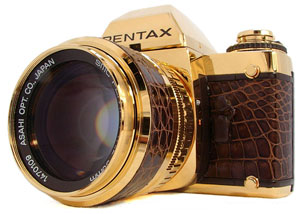Yet another new model? Wasn’t the latest iteration of this camera released only a few months ago? Right, that lineup’s ready for another upgrade… What number eh name again? Improvements? Take Nikon, serving the high end, midrange, upper entry and entry level market with a plethora of similar names. It takes a mathematician’s analytical skills to distinguish between a D3200, D5200, D5300 and D7100, all released within one year. From D600 to D610 barely a year. Back in the film days? Nikon produced fewer cameras. The era spanned half a century with Nikon delivering 35mm rangefinders and film SLRs without and with autofocus. Digital? Just started at the turn of the millennium. But while in the film days a camera was redesigned on average every three to five years, digital consumer cameras get an (often cosmetic) overhaul every one to two years.
Prices? Going up up up, yet all camera manufacturers face difficult times. We all know that phones that became cameras eat into the once profitable business. Still, something is fundamentally wrong with the camera industry. While technology and sensors become cheaper, camera makers jump on the bandwagon of incremental improvements and pricier finishings by promising photographic nirvana which in turn leads to painful inflation in the price of camera gear.

Any good photographer will tell you, “Doesn’t depend a thing on the camera, photography is all about you, the photographer!”
Hmmm… it makes photography so much more pleasant and inspiring to work with a pleasant, inspiring tool, the more so as the industry rolls out tempting candy after candy…
Sure thing a new camera can improve ones photography, but even more so does learning how to properly use that camera and how to anticipate and really see.
And somewhere in this vicious upgrade circle a pain threshold is reached where it just doesn’t make sense anymore to let go of perfectly good, slightly older gear.
These musings actually relate to the not-too-cheap Nikon Df and a reader comment I want to highlight here. Andy Umbo writes:
As a pro, nobody I know is complaining about the camera, we all want one… everybody’s complaining about the price! Almost three grand for a D610 is just not going to make it for us. Digital photography has, for better or worse (and most of us say it’s worse) become the upgrade cash cow of the century for most of these companies.
I was using the same equipment shooting film for over 25 years until the day my clients forced me to go digital; and now I have to replace stuff every two to three years because the client wants a higher pixel rate, different feature or the stuff just breaks and is too costly to fix vs. buying a new one. For most photographers in most markets, digital upgrades are eating their retirement funds and making them live hand to mouth.
The idea that camera companies are building these “almost got it” cameras that need replacement too often is why no one can stay in business anymore. Someone who’s actually been shooting for years could sit down with a camera company and design a camera we all want with the features we all want; but then they’d sell us only one every 15 years instead of every three years. When the Nikon appeared at this price point I just said: “That’s it, I’m done…”.
And Andy adds:
I think the big problem for most of us “pros” is that the modern digital camera industry never gave us a camera we wanted anyway. It’s hard for people to understand, but I tell “amateurs” and “pro-ams” (and “pretenders”) all the time that “back-in-the-day”, the feud between Canon and Nikon, and in a smaller part Pentax and Leica, and their use by professionals, was just all advertising garbage. The amateurs’ only understanding of what pros used was based on what they read in the press, and the press covered their own.
In any given year, any town over half a million had far more professional commercial photographers and wedding photographers than photojournalists, and those professional photographers couldn’t sell anything done on a 35mm format camera to save their souls. There was ten times the amount of pros using 120, mostly Hasselblad, and view camera, in my area mostly Deardorf and Cambo, all manual.
To this day, all I want for the work I do is a manual camera, that you can actually focus on a ground glass viewfinder (instead of the fibre optics viewfinder most cameras have that are unfocusable), and a nice set of F2.8 primes. I can go on and on about this for pages, since I was there and managing a large photography department for a retailer at the dawn of digital; but you get the picture…
So back in the days 35mm was belittled. You could say digital 35mm is the new medium format… To make things worse, add the fast depreciation of digital gear. Holy camera cycle of life.
Right, blame the camera.
Or you still want that “one more lens”?
What’s the better wider angle lens?
Take a step backward.
If you have no talent, it doesn’t matter how much you spend. Your work will still be uninspired.
It may sound like an oxymoron to some but in the right hands a 5MP camera phone takes better pictures than the latest 20 something megapixel DSLR.
The best camera can get the worst pictures.
Get over it.
You make the photo. Not the camera.
It’s as simple as that.
Amen.
Still, Nikon knows that Df is hardly resistible…


